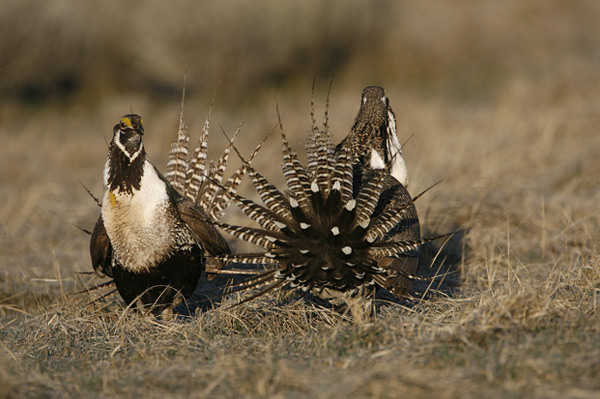‘Threatened’ listing for Gunnison sage grouse rouses political scuffle
- A pair of Gunnison sage grouse. Credit/US Fish and Wildlife Service
The recent US Fish and Wildlife Service (FWS) decision to list the Gunnison sage grouse (Centrocercus minimus) as “threatened” under the Endangered Species Act (ESA) has ignited a political fervor between the administration, environmentalists and Colorado and Utah policymakers.
“While many people hoped that the extraordinary conservation efforts by our partners in Colorado and Utah would resolve all the threats faced by the Gunnison sage-grouse, the best available science indicates that the species still requires the Act’s protection,” said FWS Director Dan Ashe in a press statement.
According to FWS, there are only about 4,700 Gunnison sage grouse left, occupying only seven to 12 percent of the species historical range in Colorado and Utah. Concurrent with publication of the final rule, FWS is designating 1.4 million acres in Colorado and southeastern Utah as critical habitat for the species. The listing was first proposed by the service in Jan. 2013, citing habitat loss and fragmentation caused by human development. The decision has no direct bearing on FWS’s still pending decision to list the related greater sage grouse (Centrocercus urophasianus) as endangered under the ESA, which the agency is evaluating independently.
Many agricultural landowners will not be affected by the bird’s new status. Those who have committed to Candidate Conservation Agreements with Assurances will be in full compliance with the ESA. Participating landowners took steps to improve sage grouse habitat and survival by, for example, removing invasive cheatgrass and putting ramps into stock tanks to help trapped birds escape drowning.
Participants in the USDA’s Sage Grouse Initiative, Working Lands for Wildlife, and Conservation Reserve Program will also be in compliance.
The threatened listing differs from an endangered listing in that it provides more flexibility to states and allows FWS to issue special rules that either reduce or expand Endangered Species Act protections for a listed species. Nonetheless, the agency’s decision drew accusations of federal government overreach from lawmakers across the ideological spectrum as well as criticism from the environmental advocacy community in favor of stronger protections.
Gov. John Hickenlooper (D-CO), Sen. Michael Bennet (D-CO) and Sen. Mark Udall (D-CO) issued a joint statement, claiming the decision threatens to undermine the conservation work done at the state and local government level to preserve the species.
“We are deeply disappointed the US Fish and Wildlife Service chose to ignore the extraordinary efforts over the last two decades by the state, local governments, business leaders and environmentalists to protect the Gunnison sage grouse and its habitat,” said Hickenlooper. “This sends a discouraging message to communities willing to take significant actions to protect species and complicates our good faith efforts to work with local stakeholders on locally driven approaches.”
In a joint press statement, Congressmen Rob Bishop (R-UT) and Jason Chaffetz (R-UT) criticized the FWS decision as unnecessarily superseding state and local conservation efforts. The lawmakers criticized the science used to justify the listing and asserted the federal protection would restrict energy development, ranching and recreational activities important to communities in affected regions.
“States, local governments, and public land users are working collaboratively to restore the Gunnison sage grouse populations and progress continues to be made,” stated Rep. Bishop. “Restoration of the species is not something that can fully be measured overnight and it’s premature to supersede state and local actions with an ESA listing.”
Congressman Bishop is expected to assume the chairmanship of the House Natural Resources Committee next year. The committee has primary jurisdiction over legislation that would reauthorize and reform the Endangered Species Act.
Outgoing Natural Resources Committee Chairman Doc Hastings (R-WA) asserted the sage grouse listing is another example of why it is necessary for Congress to pass legislation to “update the Endangered Species Act and make the law more effective for species and people by using the best available science and increasing transparency, including the work of states, local stakeholders, and communities.”
The Nov. 12 deadline was mandated by a settlement agreement from a WildEarth Guardians lawsuit over a backlog of species listing decisions. WildEarth Guardians and several other environmental organizations plan to file suit against FWS in favor of a full “endangered” listing for the species, arguing the birds are at imminent risk of extinction and warrant full protection.
